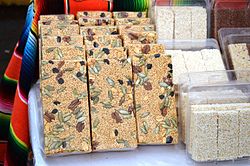Alegría is a Mexican candy made from seeds of amaranth and honey or sugar that is produced mainly in the town of Santiago Tulyehualco in the Xochimilco borough of Mexico City. It has been known as alegría, Spanish for "joy," since the 16th century.[1][2][3] The alegría of Tulyehualco was officially declared Patrimonio Cultural Intangible de la Ciudad de México (an intangible part of the cultural heritage of Mexico City) in September 2016.[4]
 Alegrías | |
| Type | Candy |
|---|---|
| Course | Snack |
| Place of origin | Mexico |
| Ingredients generally used | Seeds of amaranth and honey or sugar |
Amaranth is a plant native to Mexico. In prehispanic times, in addition to forming part of the diet of the indigenous people, it was also used as currency and for ceremonial purposes. Figures of amaranth and honey were made as offerings to the gods.[3] In order to stop those religious practices, Hernán Cortés banned the cultivation of amaranth. The plant began to fall into disuse[5] because those who continued to cultivate it faced being put to death as punishment.[2]
Alegrías have become the most popular way of consuming amaranth.[5] These sweets are prepared by puffing the seeds in a hot pan without oil.[6] The popping starts in seconds. When finished, they are mixed with honey or sugar syrup and sometimes with additions such as roasted seeds (e.g. peanut or pumpkin) or chopped dried fruits. The mixture is molded into different forms and is packaged for sale.[1]
See also
editReferences
edit- ^ a b Long-Solis, Janet; Vargas, Luis Alberto (2005). Food culture in Mexico. Greenwood Publishing Group. p. 41. ISBN 9780313324314.
- ^ a b Cardona, Gloria (2007). Delicias vegetarianas de México. Editorial Pax México. p. 18. ISBN 9789688608364.
- ^ a b "Feria de la Alegría y el Olivo 2011". Página web oficial del Gobierno del Distrito Federal. Archived from the original on July 24, 2011. Retrieved April 18, 2011.
- ^ Jefatura de Gobierno (September 2, 2016), "Decreto por el que se declara Patrimonio Cultural Intangible de la Ciudad de México a la "Alegría de Tulyehualco"" (PDF), Gaceta Oficial de la Ciudad de México, Gobierno de la Ciudad de México, retrieved April 15, 2017
- ^ a b "Historia del Amaranto". Asociación Mexicana del Amaranto. Archived from the original on June 2, 2012. Retrieved April 18, 2011.
- ^ Martin, Franklin W.; Telek, Lehel (1979). Vegetables for the Hot Humid Tropics Part 6. Amaranth and Celosia, Amaranthus and Celosia. U.S. Department of Agriculture. p. 17.
External links
edit- Media related to Alegrias at Wikimedia Commons